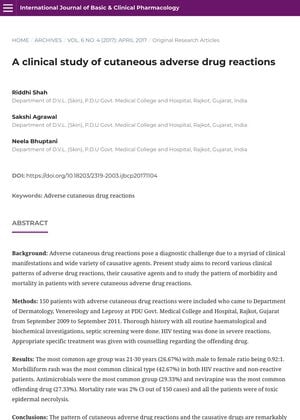A Clinical Study of Cutaneous Adverse Drug Reactions
March 2017
in “
International journal of basic and clinical pharmacology
”

TLDR Skin reactions to drugs are most often rashes caused by antibiotics, with nevirapine being the most common culprit; knowing these patterns can improve treatment and outcomes.
The study conducted by Riddhi Shah, Sakshi Agrawal, and Neela Bhuptani from 2009 to 2011 involved 150 patients with adverse cutaneous drug reactions. The most common age group affected was 21-30 years (26.67%), and the male to female ratio was 0.92:1. The most common clinical type of reaction was a morbilliform rash (42.67%), and the most common group of causative agents were antimicrobials (29.33%), with nevirapine being the most common offending drug (27.33%). The mortality rate was 2% (3 out of 150 cases), all of which were cases of toxic epidermal necrolysis. The study concluded that the pattern of cutaneous adverse drug reactions and the causative drugs were notably different, and understanding these patterns and agents can aid in better management and reduced consequences, particularly in severe adverse cutaneous drug reactions.




